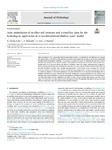Joint assimilation of satellite soil moisture and streamflow data for the hydrological application of a two-dimensional shallow water model

Use este enlace para citar
http://hdl.handle.net/2183/33760
A non ser que se indique outra cousa, a licenza do ítem descríbese como Atribución-NoComercial-SinDerivadas 3.0 España
Coleccións
- Investigación (ETSECCP) [826]
Metadatos
Mostrar o rexistro completo do ítemTítulo
Joint assimilation of satellite soil moisture and streamflow data for the hydrological application of a two-dimensional shallow water modelData
2023Cita bibliográfica
García-Alén, G., Hostache, R., Cea, L., Puertas, J. (2023). Joint assimilation of satellite soil moisture and streamflow data for the hydrological application of a two-dimensional shallow water model. Journal of Hydrology, 621, 129667. https://doi.org/10.1016/j.jhydrol.2023.129667
Resumo
[Abstract:] Data assimilation (DA) in physically-based hydrodynamic models is conditioned by the difference in temporal and spatial scales of the observed data and the resolution of the model itself. In order to use remote sensing data in small-scale hydrodynamic modelling, it is necessary to explore innovative DA methods that can lead to a more plausible representation of the spatial variability of the parameters and processes involved. In the present study, satellite-derived soil moisture and in situ-observed streamflow data were jointly assimilated into a high-resolution hydrological-hydrodynamic model based on the Iber software, using the Tempered Particle Filter (TPF) for the dual estimation of model state variables and parameters. Twelve storm events occurring in a 199 km2 catchment located in NW Spain were used for testing the proposed approach. A 3-step procedure was followed: (1) sensitivity analysis of the model parameters; (2) joint assimilation of soil moisture and discharge data to estimate correlations between observations and model parameters; (3) joint assimilation of soil moisture and discharge data using an initial set of particles and parameter standard deviations derived from prior information. The numerical model correctly reproduces the observed data, with an average Nash-Sutcliffe efficiency (NSE) value of 0.74 over the 12 events when the prior information is used. The approach described is shown to be most efficient with storm events that produce isolated peak discharges.
Palabras chave
Hydrodynamic modelling
Iber+
Flood forecasting
Tempered particle filter
Shallow water equations
Data assimilation
Iber+
Flood forecasting
Tempered particle filter
Shallow water equations
Data assimilation
Descrición
Financiado para publicación en acceso aberto: Universidade da Coruña/CISUG
Versión do editor
Dereitos
Atribución-NoComercial-SinDerivadas 3.0 España






